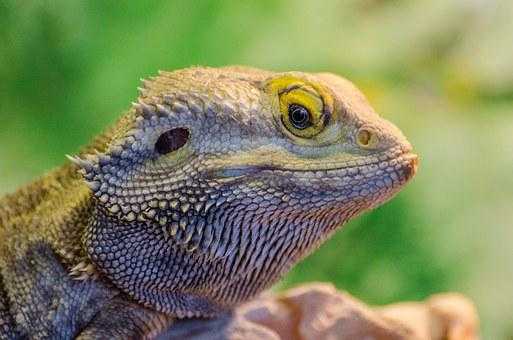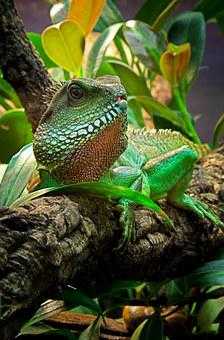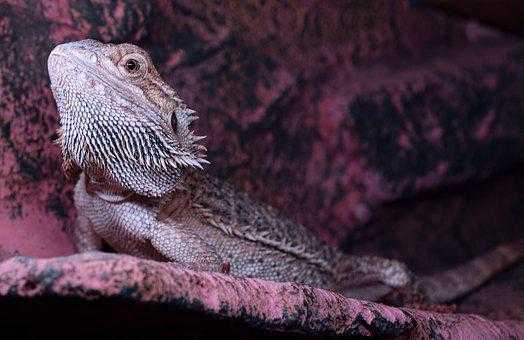Are you wondering how to tell if your bearded dragon is pregnant? Congratulations! It’s an exciting time, but there are a few things you need to know in order to care for her and the baby dragons. In this blog post, we will discuss the signs of pregnancy in bearded dragons, how to take care of them during gestation, and what to do when they give birth.

How to tell if your Female bearded dragon is pregnant
If you’re the proud owner of a female dragon, you may be wondering if she is pregnant. Here are a few signs to look for that may indicate that your bearded dragon is expecting:
1. Growth in the abdominal area – You will begin to notice a bulge in your bearded dragon’s belly. This is a sign that she is carrying eggs.
2. Increased appetite – Pregnant beardies typically have an increased appetite as their body is working hard for egg production.
3. Change in mood/behavior – Some female beardies can become more aggressive or moody when they get pregnant because of hormones change.
4. Nesting behavior – A Bearded dragon will often start to dig and burrow when she is ready to lay her eggs. If you notice your female dragon exhibiting any of these behaviors, there is a good chance she is pregnant and you should consult with a reptile veterinarian for further guidance.
How Long Is A Bearded Dragon Pregnant For?
A healthy bearded dragon can lay clutches of 20-30 eggs at a time, and will often lay 2-3 clutches per year. Once the eggs are laid, they must be incubated for 50-60 days before they hatch. During this time, it is important to keep the eggs at a consistent temperature and humidity level in order to ensure that they develop properly. After the eggs hatch, the baby dragons will be approximately 4-6 inches long and will need to be kept in a separate enclosure from their parents.

If you are thinking about breeding your bearded dragons, it is important to do your research beforehand to make sure that you are prepared for the process. Pregnancy in bearded dragons lasts for about 60 days. There are several ways to tell if your bearded dragon is pregnant. One way is to look for gravid spots, which are dark spots on a female dragon’s body that indicate that she is carrying eggs.
You may also notice that your dragon’s abdomen looks slightly swollen or enlarged. If you suspect that your dragon is pregnant, it is important to take her to the vet for an examination. An experienced reptile vet will be able to confirm the pregnancy and make sure that your dragon is healthy and doing well.
Does A Pregnant Bearded Dragon Need A Place To Lay Eggs
A pregnant bearded dragon usually needs a place to lay her eggs within two weeks of becoming gravid, or pregnant. The egg-laying process is called oviposition, and it can take up to three days for your dragon to lay all of her eggs. During this time, she may become restless and try to dig in her enclosure.
If you think your dragon is gravid, it’s important to provide her with a place to lay her eggs. You can do this by adding an egg-laying box to her enclosure. The box should be filled with sand or vermiculite, and it should be large enough for your dragon to turn around comfortably. Once your dragon has laid her eggs, she will bury them and return to her normal activities.
However, it is important to check the box regularly to make sure that the eggs are not being disturbed by other animals in the enclosure. If you find that the eggs have been damaged, you can remove them from the box and incubate them yourself. Bearded dragons typically lay between 20 and 30 eggs at a time, so be prepared for a bountiful clutch of eggs.
What to do when Female Bearded Dragons Lay Their Eggs
A bearded dragon’s gestation period is about 60 to 90 days. Once they lay their eggs, it’s important to remove them from the tank as soon as possible. If you leave the eggs in the cage, they could be eaten by other dragons or reptiles. You will also need to provide your pregnant dragon with a nesting box.
The nesting box should be filled with sand so that she can lay eggs in it. Once she has laid them, you will need to incubate them. You can do this by placing them in a container filled with vermiculite or perlite and then putting the container in a warm place. The incubation period takes about 60 to 90 days. After the eggs have hatched, you’ll need to provide the baby dragons with food and water. They should also be kept in a separate cage from their parents.
Why do Bearded Dragons Lay Infertile Eggs
Bearded dragons are also oviparous, meaning they lay eggs rather than give birth to live young. Pregnant bearded dragons will often lay infertile eggs.
There are two main reasons why dragons lay eggs that are not fertile. The first reason is that they are not sexually mature when they reach puberty, which is typically between 8 and 12 months old.

The second reason is that bearded dragons are Reptiles who do not have an estrus cycle like mammals, so they do not ovulate every month. Instead, they go through what is called an “egg-laying cycle.” This cycle lasts for about two months, during which time the female will lay a clutch of eggs. After the eggs are laid, the male will fertilize them. However, if the female does not mate with a male during her egg-laying cycle, the eggs will be infertile.
Is It Possible For A Female Bearded Dragon To Get Pregnant Without A Male Bearded Dragon?
Now that you know how to tell if your bearded dragon is pregnant, you might be wondering if it is possible for her to get pregnant on her own.
A female bearded dragon can get pregnant without a male bearded dragon by a process called parthenogenesis. This is when the female’s egg develops into an embryo without being fertilized by a male’s sperm. While this is possible, it is very unlikely to happen because it requires a certain genetic mutation.
Many people might be surprised to learn that a female dragon can get pregnant without a male dragon. In fact, this is a relatively common occurrence in the wild, where males are often scarce. Female bearded dragons can store sperm for several months, and will often mate with multiple males over the course of a season. As a result, it is not uncommon for a female to become pregnant without ever encountering a male.
Conclusion: How To Tell If Your Bearded Dragon Is Pregnant
Now that you know the signs to look for, you can decide if your bearded dragon is with eggs. Females will exhibit many, if not all, of these behaviors: nesting, increased appetite, weight gain, and changes in coloration.
If you observe these behaviors in your female dragon, pregnancy is a strong possibility. Of course, the only sure way to tell if your bearded dragon is gravid is to take her to the vet for an ultrasound. However, by observing the signs above, you can get a pretty good idea of whether or not your reptilian friend is expecting. You can then be fully prepared for when your bearded dragon lays eggs.
